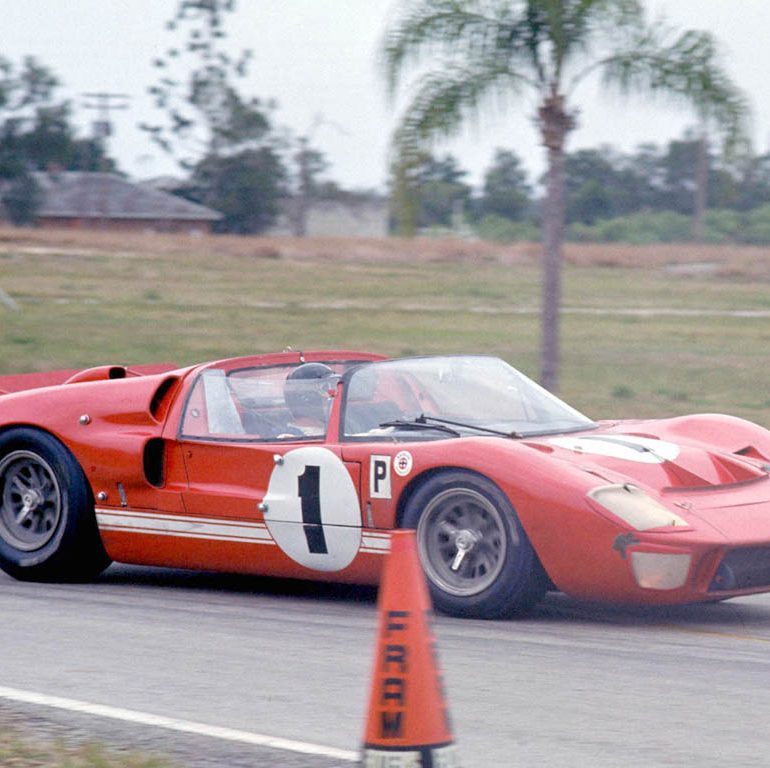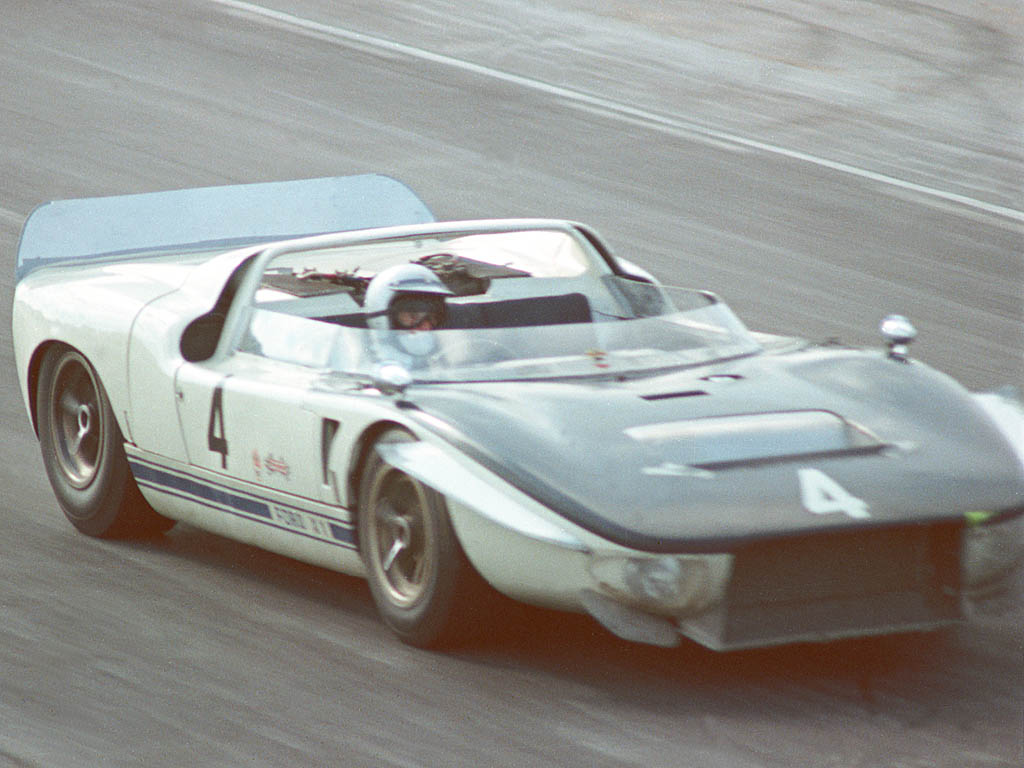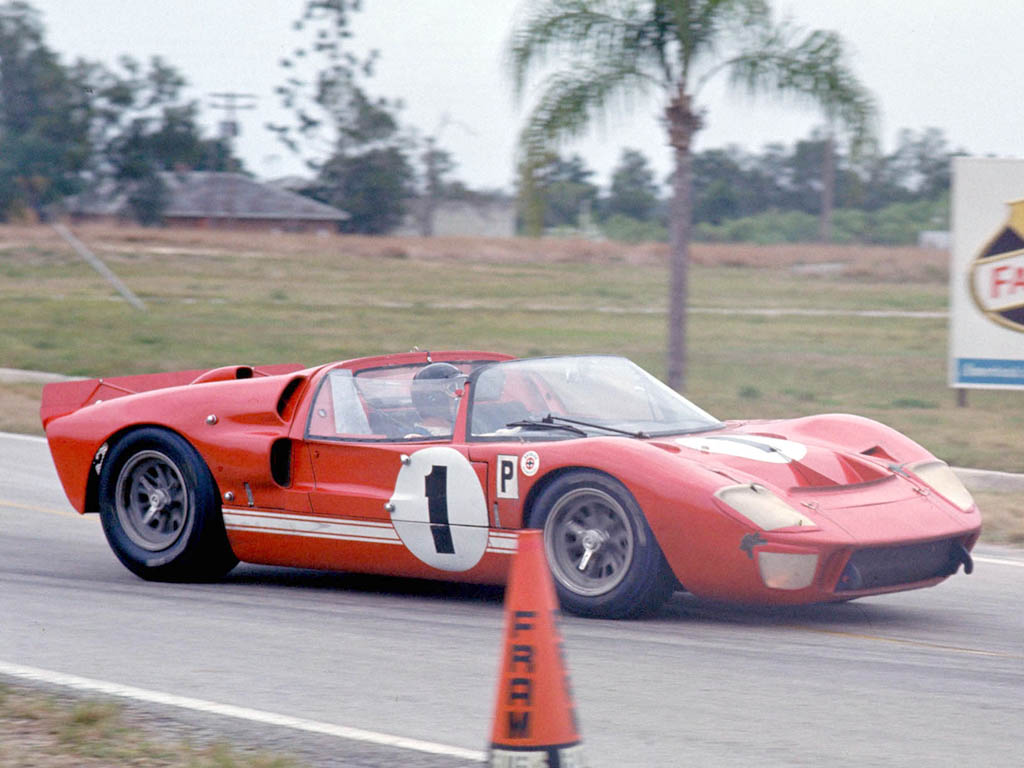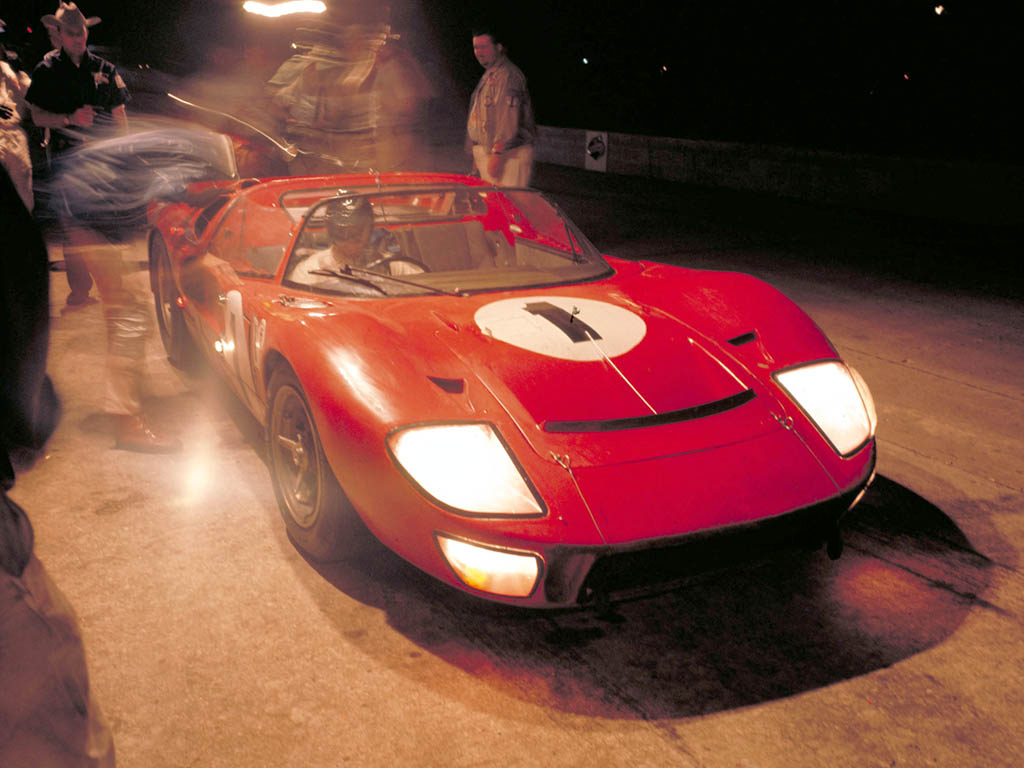1965 Ford GT40 X1
During their initial development year, Ford had setup Kar Kraft and Ford Advanced Vehicles for construction of their first five GTs. Talent within these companies included Eric Broadley of Lola, Roy Lunn of Kar Kraft and Phil Remington. Despite having John Wyer managing the team, reliability, especially in the areas of brake cooling and transmissions proved to be a problem on the track.
For the following year, Ford swallowed up even more talent before the specification of the production GT40 was finalized. Many different teams worked on prototype designs to test various configurations on the GT40 theme. Some of the these modifications included an open-top body, new noses, larger engines, but the most interesting car was produced by McLaren Racing Limited.
The Aluminum GT40
In late 1965, two experimental, all-alumimum GT40 chassis were manufactured by Abbey Panels in England. One of the tubs was shipped back to Ford’s Kar Kraft’s Dearborn for testing, never to be seen again. The remaining aluminum chassis, GT110, was shipped to McLaren to become a lightweight open version of the 427 GT40 which raced at the 1965 LeMans. Under contract, McLaren would assemble, prepare and race the aluminum car.
Providing a basis for the X1 were the two 427 GT40s developed in a rush by Kar Kraft for Le mans. These cars, chassis GT106 and GT107, featured a long nose designed by Roy Lunn. This distinguishing feature of the prototype 427 cars was lent over to the X1 roadster.
Due to the steel chassis, most of the other prototype 427 GT40s weighed a hefty 2900 lbs. The goal set for McLaren was to reduce this number by 1000 lbs. At McLaren, Howden Ganley considered every component of the GT40 to give it a well needed diet. With the aluminum chassis and lighter Hewland LG 500 Gearbox, the X1 weighted 1900 lbs after modifications.
On The Track
Unfortunately the X1 was unable to secure a victory in its original McLaren configuration. At the hands of Chris Amon, the X1 raced in four times in 1965, most of which resulted in the car not finishing.
To the disappointment of McLaren, the X1 was handed over to Shelby American at the end of the 1965 season. Shelby studied and the roadster and then it was sent to Kar Kraft to be extensively modified as a test car. Heavier headers and a heavier T44 manual transmission were installed. Combined with an additional front fuel tank the balance of the original lightweight roadster was lost.
Other temporary modifications to the X1 included testing of Ford’s two speed automatic transmission, and aerodynamic work, both of which led to shape the Ford J Car. After the testing was finshed, a standard Mark II nose was fitted to the X1.
The final race for GT110 came at the 1966 Sebring Race. Driven by Ken Miles and Lloyd Ruby, the red painted roadster took the overall victory despite competition from Ferrari’s 330 P3, Chapparals and Porsches. After the race, provisions were made for Holman & Moody to rebuild X1, but sadly the plan was never acted upon. Instead, the car was ordered destroyed by customs officials.
Conclusion
The purpose of the X1 was to provide Ford with further information on the potential of the 427, provide a basis for the J Car and act as a test mule for various engines and transmissions. The fact that such an experimental car managed to secure a victory at Sebring is remarkable, especially given that most of the other cars were production GT40s.
Although the X1 was never competitive in any race other than Sebring it provided Ford with a considerable background to develop new cars such as the Ford J Car and F3L.
Ludvigsen, Karl E. The Inside Story of The Fastest Fords, Style Auto Editrice: 1970.
Pritchard, Anthony. Ford vs Ferrari: The Battle for LeMans, Zuma Matketing: 1984.
Jones, Gordon et. al. The FORD That Beat FERRARI: A Racing History of the GT40, Kimberley’s, London: 1985.
Spain, Ronnie. GT40, An Individual History and Race Record, Osprey Publishing: 1986.
Story by Richard Owen
In Detail
| type | Series Production Car |
| engine | Galaxie Water-Cooled, 90 Degree V8 w/Dry Sump Lubrication |
| position | Mid-Longitudinal |
| aspiration | natural |
| valvetrain | 2 Valves per Cyl, Pushrod Actuated |
| fuel feed | 58 DCO-4 Weber Side Drafts |
| displacement | 6997 cc / 427.0 in³ |
| bore | 108 mm / 4.25 in |
| stroke | 96 mm / 3.78 in |
| compression | 12.1:1 |
| power | 367.6 kw / 493 bhp @ 6500 rpm |
| specific output | 70.46 bhp per litre |
| bhp/weight | 571.93 bhp per tonne |
| torque | 721.3 nm / 532 ft lbs @ 4000 rpm |
| body / frame | Fibreglass Body over Sheet-Aluminum Semi-Monocoque |
| driven wheels | RWD w/LSD |
| front tires | Firestone Indy 9:20 x 15 |
| rear tires | Firestone Indy 12:00 x 15 |
| front brakes | Kelsey-Hayes Vented Discs w/Girling Calipers |
| rear brakes | Kelsey-Hayes Vented Discs w/Girling Calipers |
| front wheels | F 38.1 x 20.3 cm / 15.0 x 8 in |
| rear wheels | R 45.7 x 24.1 cm / 18 x 9.5 in |
| f suspension | Double Wishbones w/Coil Springs, Tube Shocks, Anti-Roll Bar |
| r suspension | Transverse Top Link w/Lower Wishbone, Trailing Arms, Coil Springs, Anti-Roll Bar |
| curb weight | 862 kg / 1900 lbs |
| front track | 1397 mm / 55 in |
| rear track | 1410 mm / 55.5 in |
| length | 4343 mm / 171 in |
| width | 1753 mm / 69 in |
| height | 965 mm / 38 in |
| transmission | Hewland LG500 4-Speed Manual |







